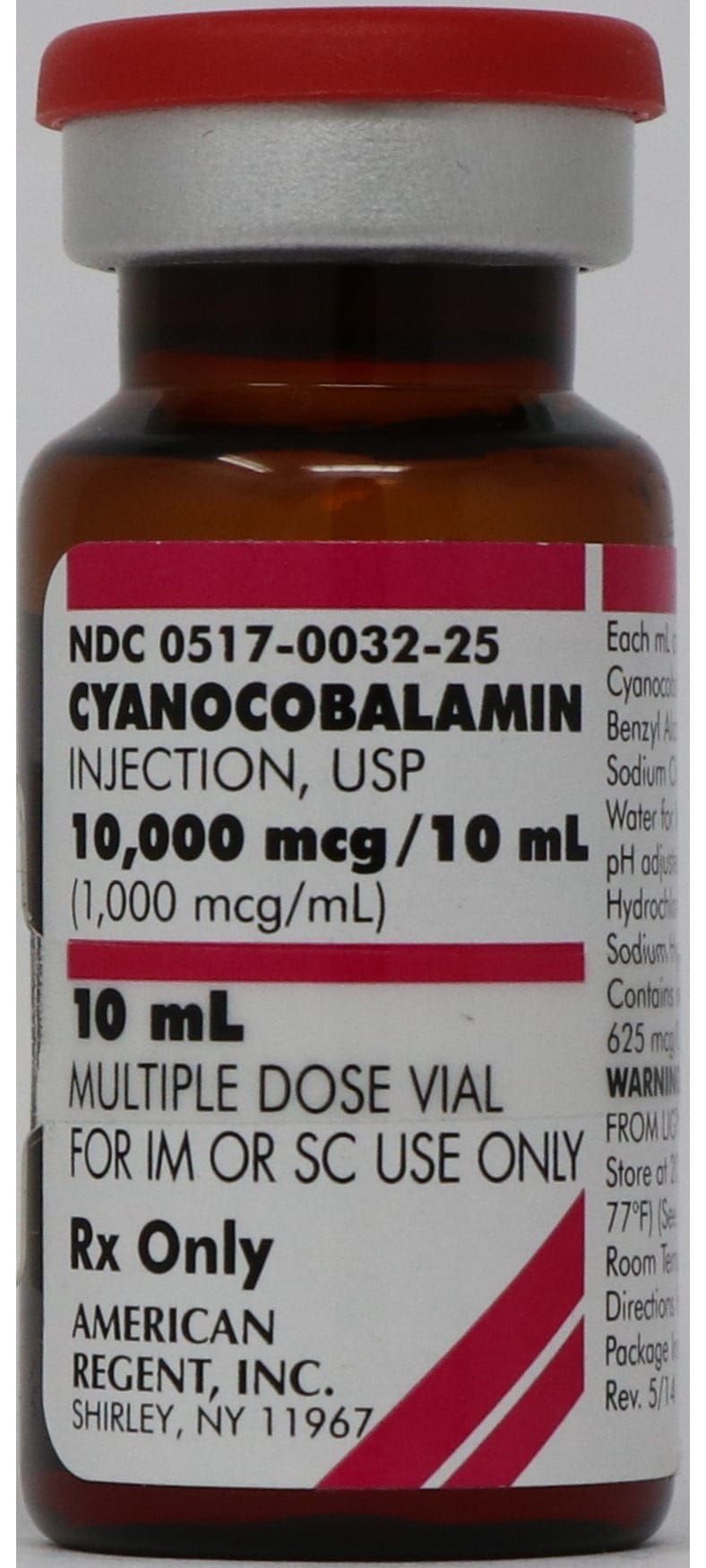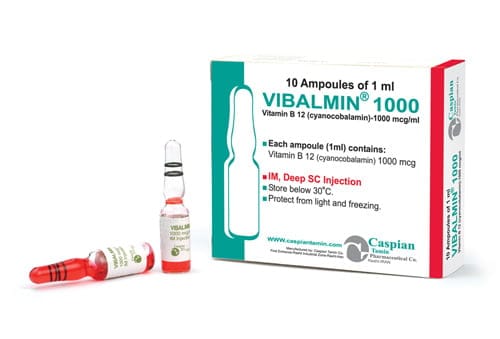Shipping with this method takes 3-5 days
Cyanocobalamin® Injection and Tablets for Vitamin B12 Deficiency
Stock up and Save - Get 20% off when you buy 3 or more of any one product. Use code SAVE20 at checkout.
Coupon code cannot be combined with other offers. Sale applies to all products originating from Canada. Maximum allowable quantity equal to a 90 day supply per single order.
Price range: $35.99 through $67.99
Secure Encrypted Payments
Cyanocobalamin is a form of vitamin B12 used to treat and prevent deficiency. Many people use it for pernicious anemia and related B12 problems. You can order cyanocobalamin from Canada with US delivery from Canada, and compare options without insurance.
What Cyanocobalamin Is and How It Works
Cyanocobalamin® is a synthetic form of vitamin B12. It supports red blood cell production and nerve function. The treatment helps restore low B12 levels caused by poor intake or absorption problems.
YouDrugstore is a licensed Canadian pharmacy in Manitoba. Pharmacists review prescriptions before dispensing.
As a cofactor in DNA synthesis, this medicine helps correct megaloblastic anemia due to B12 deficiency. When malabsorption is present, injections bypass the gut to deliver B12 directly. People who cannot get enough B12 from foods or supplements may benefit from vitamin b12 cyanocobalamin injection. Your prescriber decides the route and plan based on the diagnosis.
Who It’s For
This treatment is used for dietary deficiency, pernicious anemia, and deficiency from GI surgery or disease. It can also support replacement in certain drug-induced absorption issues. Those with Leber’s hereditary optic neuropathy or a known cobalt or cyanocobalamin allergy should avoid it. People with severe anemia need medical supervision as levels normalize.
It may be used in adults and, when directed by a clinician, in pediatric patients. Patients on long-term acid suppression or certain diabetes medicines may have reduced B12 absorption. Ask a healthcare professional whether cyanocobalamin b12 vitamin is suitable for your situation.
Dosage and Usage
Your prescriber will choose injection or oral dosing depending on cause and severity. Clinicians may begin with more frequent parenteral doses, then adjust to a maintenance schedule. For dietary deficiency with intact absorption, oral therapy may be used. For pernicious anemia, many patients remain on ongoing maintenance plans.
Follow the instructions on your prescription label. If you inject, a nurse or clinician should first show you technique. Use single-use needles and proper hygiene. For tablets, take consistently at the same time each day, with or without food unless directed otherwise. Do not change your dose or route without medical advice.
Strengths and Forms
This medicine is available as:
- Injectable solution in vials for parenteral use, commonly 1000 mcg/mL
- Oral solid forms, including tablets or sublingual options such as 1000 mcg
Availability can vary by manufacturer and country. Your order may be filled with an equivalent generic from a trusted supplier.
Missed Dose and Timing
If you miss a tablet dose, take it when you remember unless it is near the next dose. If it is close, skip the missed one and resume your regular schedule. Do not double up. If you miss an injection, contact your prescriber for guidance on timing. Keep a simple reminder system to stay on track.
Storage and Travel Basics
Store vials and tablets at room temperature, away from light and moisture. Do not freeze injectable solutions. Keep all medicines out of reach of children. Leave vials and blister packs in the original packaging until use to protect them. If you travel, bring your prescription, supplies, and a small sharps container for safe disposal.
For trips, pack medicines in your carry-on with a copy of your prescription. A travel letter can help at security if you carry syringes. Do not store vials in a hot car or near heating sources. Ask your pharmacist if you have questions about storage during longer trips.
Pen Handling and Sharps Disposal
This therapy is usually supplied as vials, not pens. If you use syringes, place used needles in an FDA-cleared sharps container right after use. Do not recap needles. When the container is about three-quarters full, follow local rules for disposal. Many pharmacies and community programs accept sharps.
Benefits
As a B12 replacement, this therapy can help rebuild body stores and support normal red blood cell production. Parenteral administration may be preferred when absorption is impaired. Oral forms may be convenient for maintenance when absorption is sufficient. Consistent use and monitoring help guide the ongoing plan.
Side Effects and Safety
- Injection site pain or redness
- Mild diarrhea or nausea
- Headache or dizziness
- Skin rash or itching
Serious reactions are uncommon but can include hypersensitivity or anaphylaxis. Rapid correction of severe deficiency may shift electrolytes, so clinicians may monitor labs. People with Leber’s disease should not use this medicine due to risk of optic nerve damage. Seek urgent help for signs of a severe allergic reaction.
Drug Interactions and Cautions
Chloramphenicol can blunt the hematologic response to B12 therapy. Nitrous oxide inactivates B12 and may worsen deficiency in susceptible patients. Long-term use of metformin may reduce B12 absorption; discuss monitoring if you take it. Acid-reducing agents, such as proton pump inhibitors, may also affect absorption and status over time.
Learn more about metformin’s role and B12 considerations in our Metformin And Diabetes article. For acid suppression therapies, see Glumetza and Pantoprazole as examples you may discuss with a clinician.
What to Expect Over Time
Your prescriber may order blood tests to confirm rising B12 levels and improving blood counts. Symptoms such as tiredness or numbness may change gradually. Some people continue parenteral therapy long term; others may transition to an oral plan if appropriate. Keep follow-up appointments and report new symptoms to your healthcare professional.
Compare With Alternatives
Parenteral replacement can be helpful when absorption is limited. Oral forms can be an option for dietary deficiency and ongoing maintenance. If you and your clinician prefer an injectable approach, see our Vitamin B12 Injection product for a comparable therapy. For supplies, browse General Care Supplies you may need for safe administration.
Pricing and Access
Canadian pharmacy sourcing can help with transparent pricing for many medicines. You can review options, compare formulations, and discuss savings with your prescriber. Check current cyanocobalamin cost and see which form fits your plan and budget. Orders are filled by our pharmacy team and shipped discreetly. Ships from Canada to US with tracking.
Looking for current offers? See our Promotions page for updates. Checkout is encrypted to protect your information.
Availability and Substitutions
Supply can vary by manufacturer and package size. If a specific vial or tablet is not available, your prescriber may recommend a clinically suitable alternative form or schedule. For cross-border fulfilment details, you can confirm that cyanocobalamin ships to US regions we serve before you place your order.
Patient Suitability and Cost-Saving Tips
People with documented deficiency or pernicious anemia are typical candidates for therapy. Those with known hypersensitivity to cobalt or this medicine should avoid it. If you are on long-term treatment, discuss multi-month refills to reduce pharmacy trips. Set refill reminders so you do not run low. Ask your clinician whether financial assistance or insurance coverage applies.
For out-of-pocket buyers, choose the form that meets your needs and talk with our team about packaging sizes. Patients who prefer flexible budgeting may explore cyanocobalamin self-pay and compare tablet versus injectable routes with their prescriber. Combining routine lab monitoring with steady adherence can help your plan stay on track.
Questions to Ask Your Clinician
- Cause of deficiency: dietary, absorption, or another reason?
- Route choice: injectable versus oral for my situation?
- Monitoring: which labs and how often?
- Duration: when to reassess maintenance therapy?
- Interactions: do my medicines affect B12 status?
- Safety: what side effects should I watch for?
Authoritative Sources
- DailyMed: Cyanocobalamin Injection
- Health Canada Drug Product Database
- US Prescribing Information (Reference)
Ready to proceed? Order from YouDrugstore for US shipping from Canada with prompt, express, temperature-controlled handling when required. Prescription required; your clinician directs therapy. This page is for general information and is not medical advice.
Express Shipping - from $25.00
Prices:
- Dry-Packed Products $25.00
- Cold-Packed Products $35.00
Shipping Countries:
- United States (all contiguous states**)
- Worldwide (excludes some countries***)
Standard Shipping - $15.00
Shipping with this method takes 5-10 days
Prices:
- Dry-Packed Products $15.00
- Not available for Cold-Packed products
Shipping Countries:
- United States (all contiguous states**)
- Worldwide (excludes some countries***)
How is Cyanocobalamin different from methylcobalamin?
Both are forms of vitamin B12. Cyanocobalamin is a stable, widely used form found in many prescriptions and supplements. The body converts it to active coenzyme forms. Methylcobalamin is already methylated and appears in some supplements. Clinicians select a form based on indication, route, and availability. Evidence supports either for correcting deficiency when dosed appropriately. Follow your prescriber’s plan and the product label.
Do I need injections or can I use tablets?
It depends on the cause of your deficiency. If absorption is impaired, injections may be preferred because they bypass the gut. If you have dietary deficiency with normal absorption, oral therapy may be considered. Your clinician will review your history, labs, and medications to choose a route. Many people continue long-term maintenance after initial correction, but schedules vary by patient.
What medicines can affect vitamin B12 levels?
Metformin may reduce B12 absorption over time. Acid-reducing agents such as proton pump inhibitors can also affect B12 status. Nitrous oxide inactivates B12 and can worsen deficiency in susceptible people. Chloramphenicol can blunt blood response to therapy. Share all medicines and supplements with your clinician so they can plan monitoring and follow the label.
Are there dietary sources of vitamin B12?
Yes. B12 is found in animal products such as meat, fish, eggs, and dairy. Many breakfast cereals are fortified. People following strict vegan diets, those with malabsorption, or older adults may still need supplementation or treatment. A dietitian or clinician can help tailor your plan. Do not change therapy without professional guidance.
What side effects should I watch for?
Common effects include mild injection site pain, diarrhea, nausea, headache, or rash. Serious reactions are rare but can include allergic responses or, in certain conditions, optic nerve problems. Seek urgent care for trouble breathing, swelling, or hives. Report new or worsening symptoms to your clinician. Always follow the product label and your prescription instructions.
Can I switch from injections to oral therapy later?
Some people transition to oral maintenance after initial correction when absorption is adequate. Your prescriber will review lab results and symptoms to decide if a switch is appropriate. They may schedule periodic monitoring to ensure levels stay within target ranges. Keep appointments and do not change your plan without medical advice.
How should I store vials and tablets during travel?
Keep medicines in original containers in your carry-on bag. Store at room temperature away from light and moisture. Do not freeze vials. Bring your prescription and a small sharps container if you use syringes. If you have a long trip or special storage concerns, ask your pharmacist for advice based on the label and local guidance.

